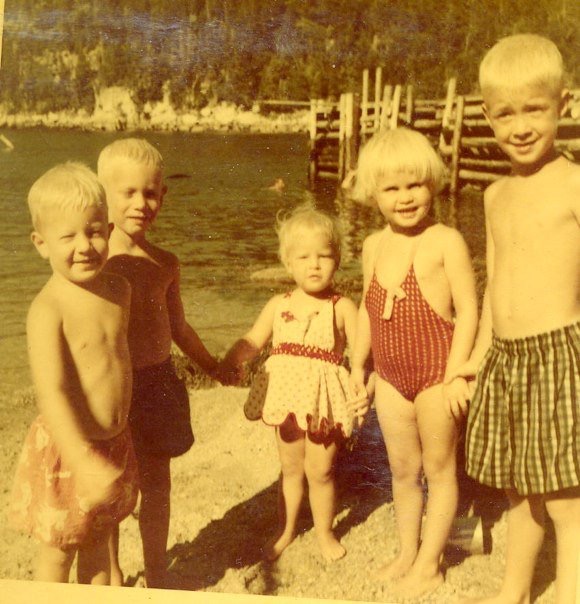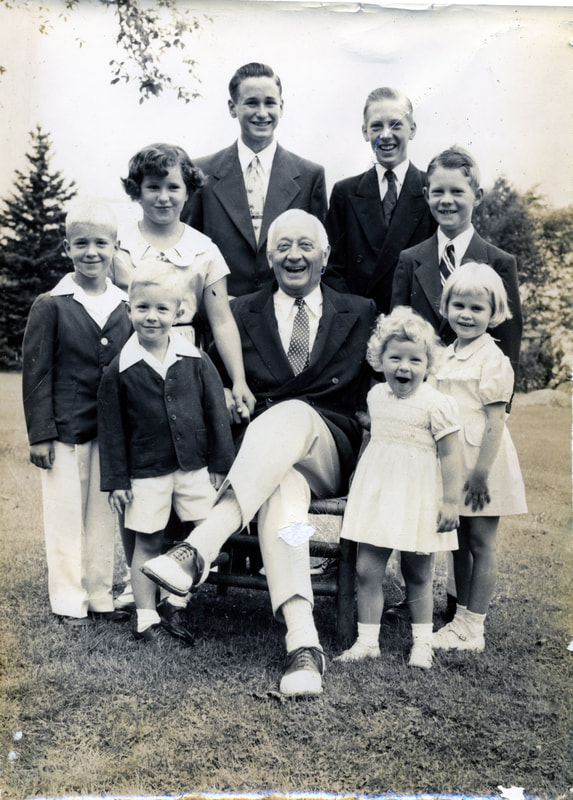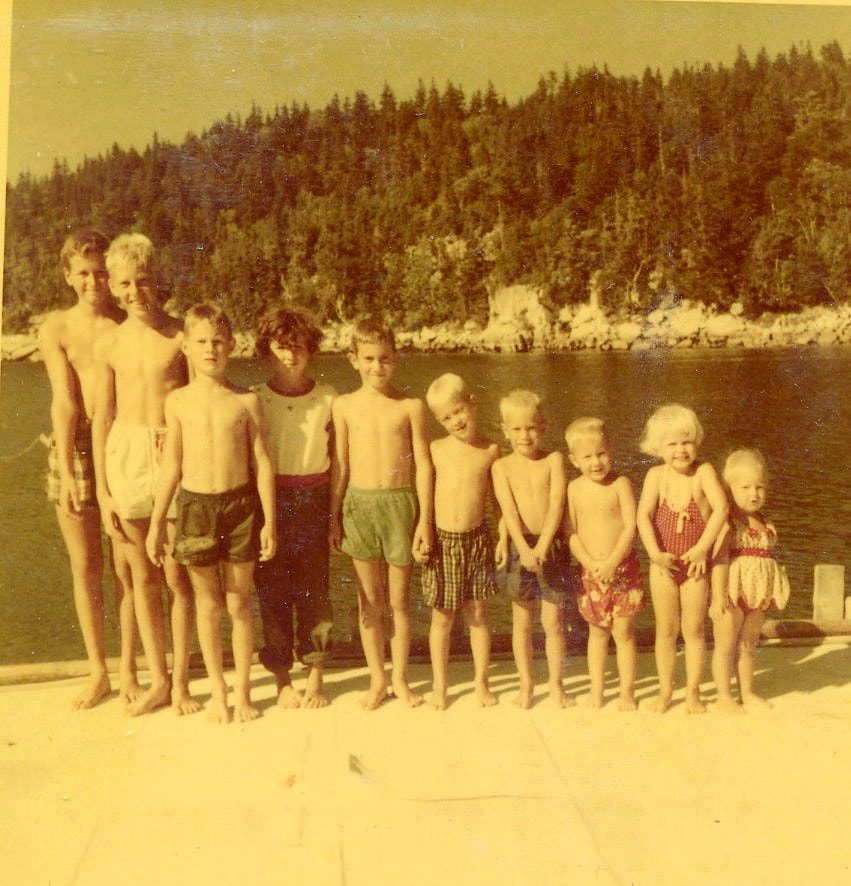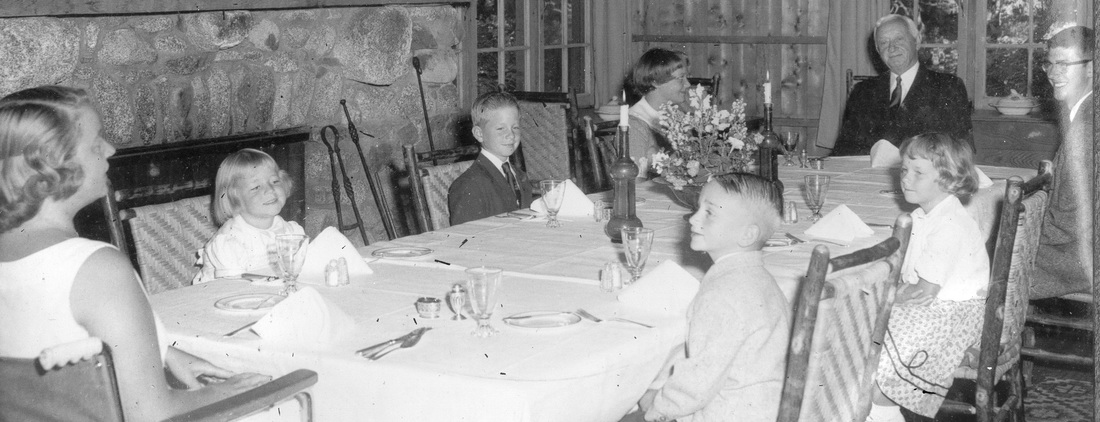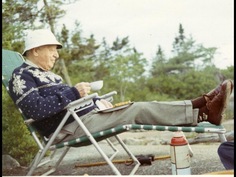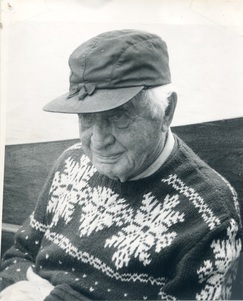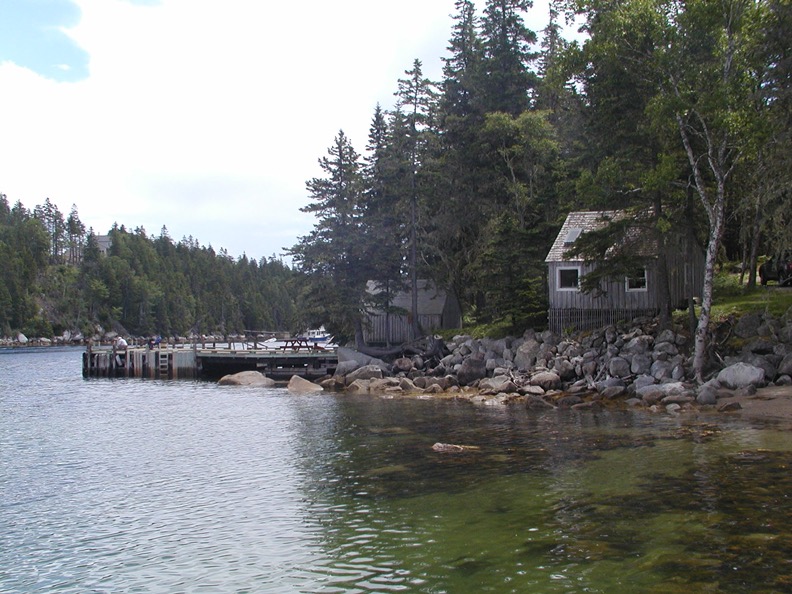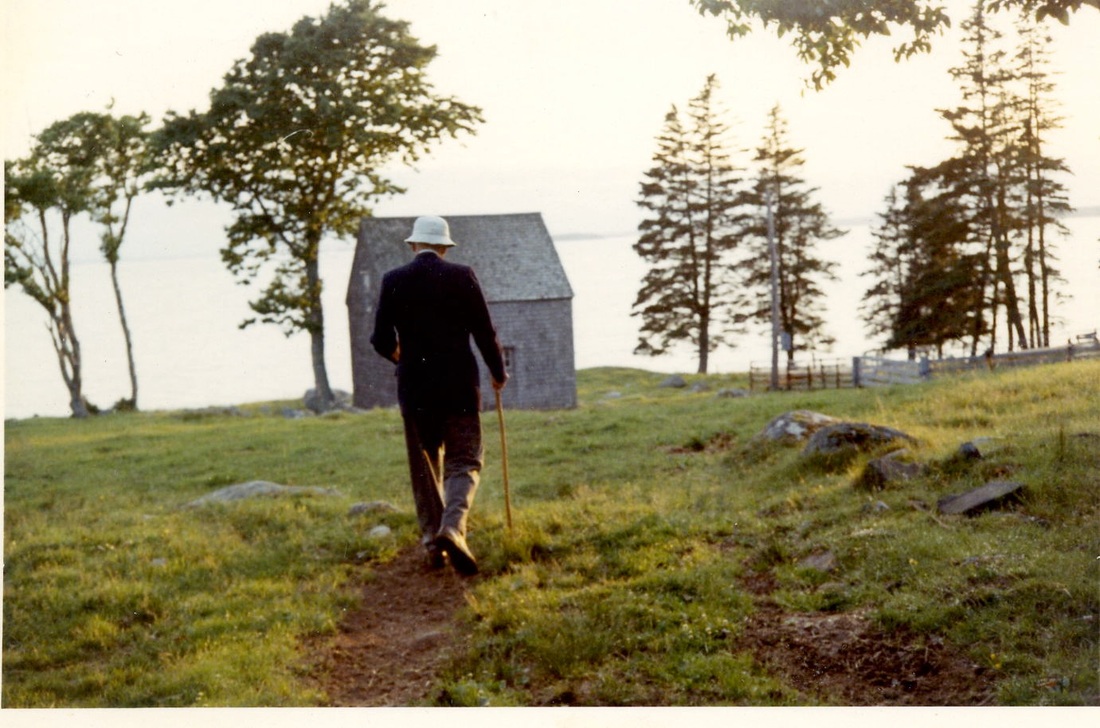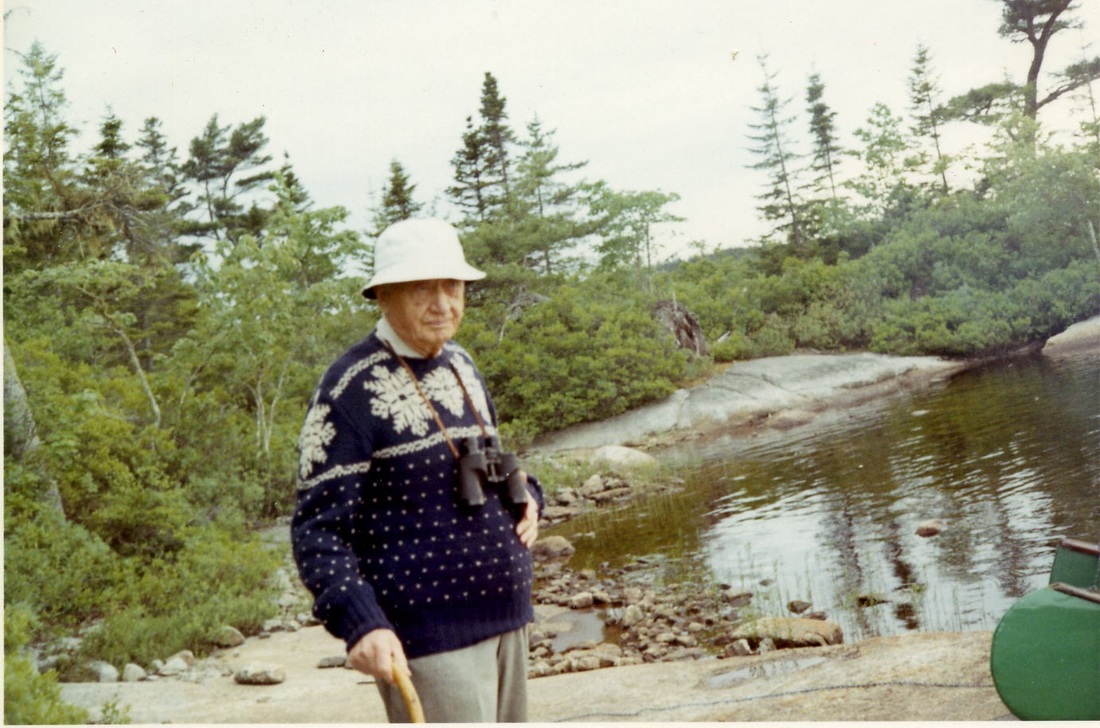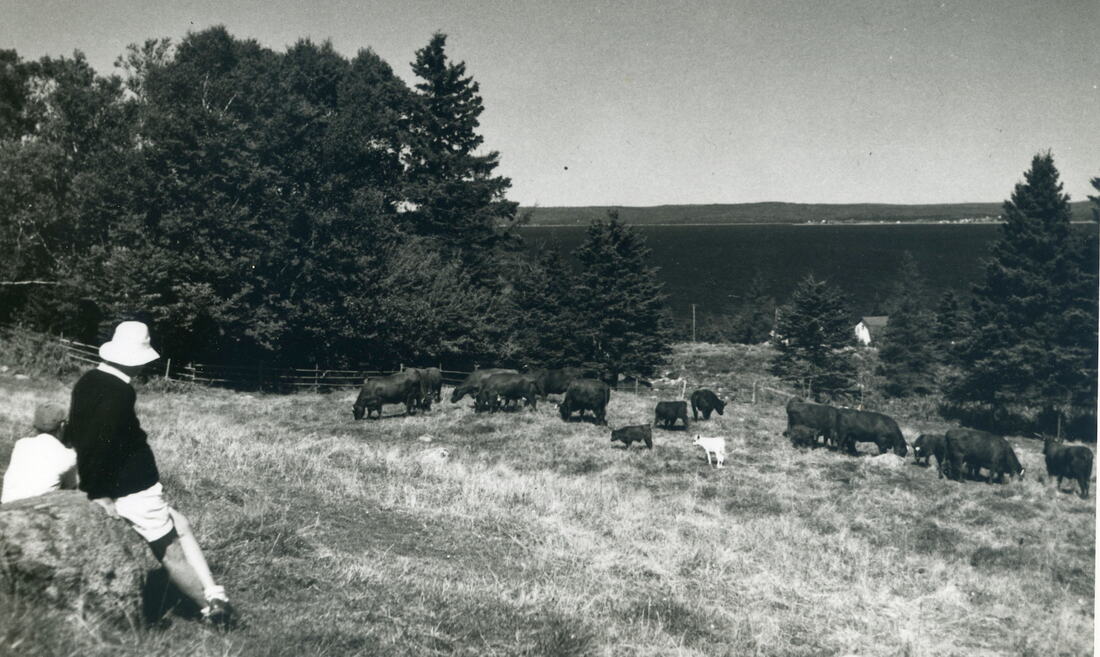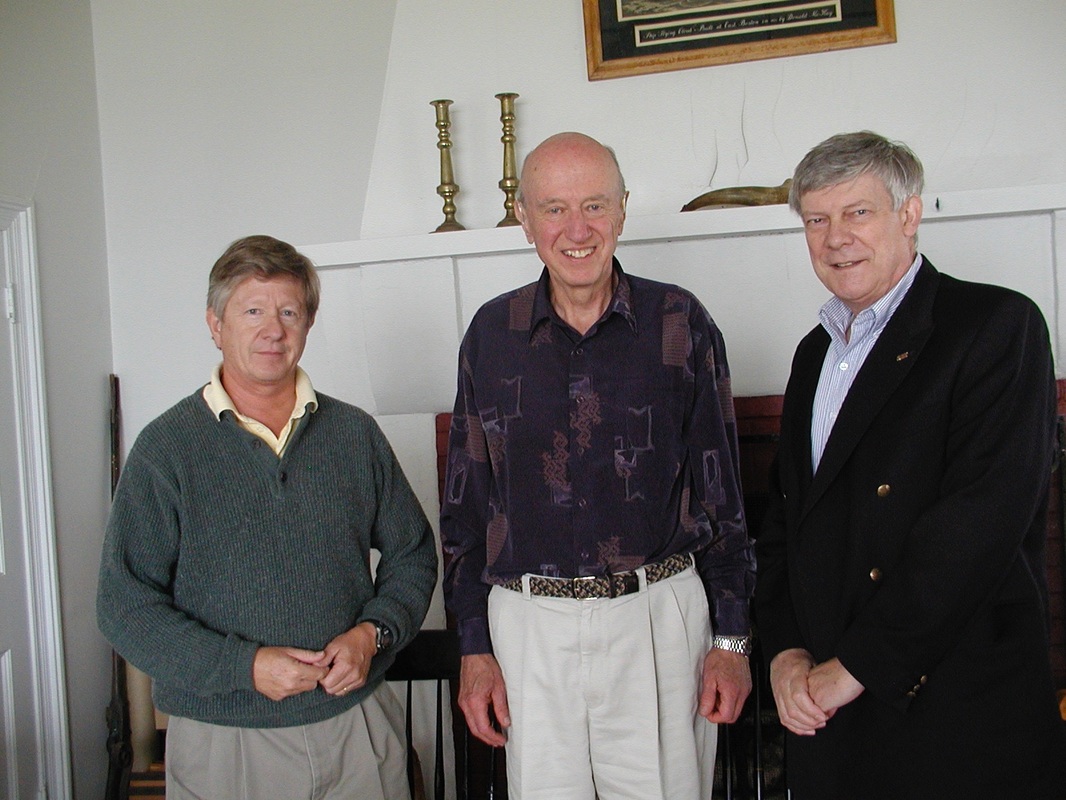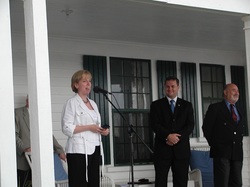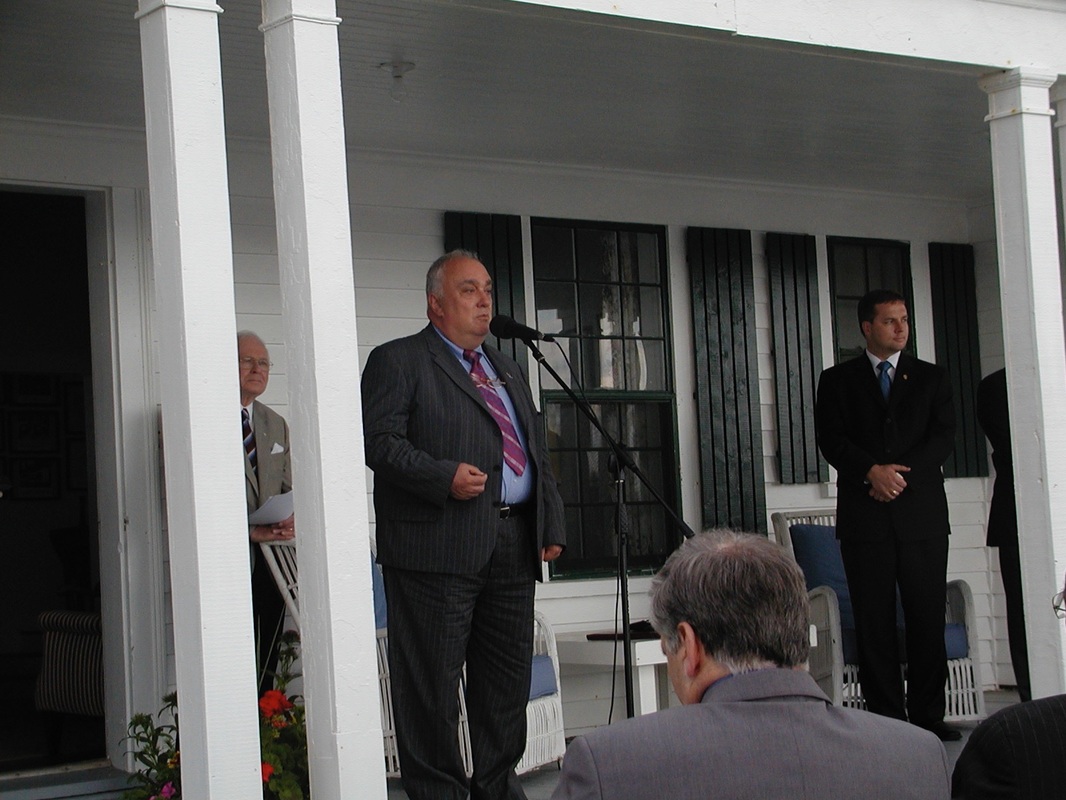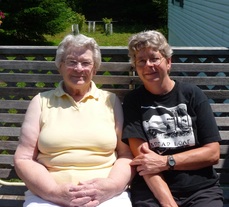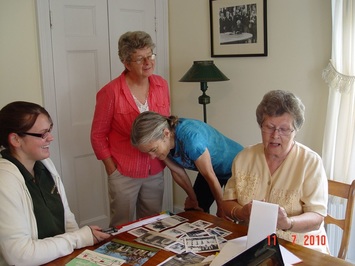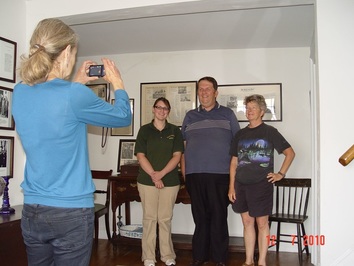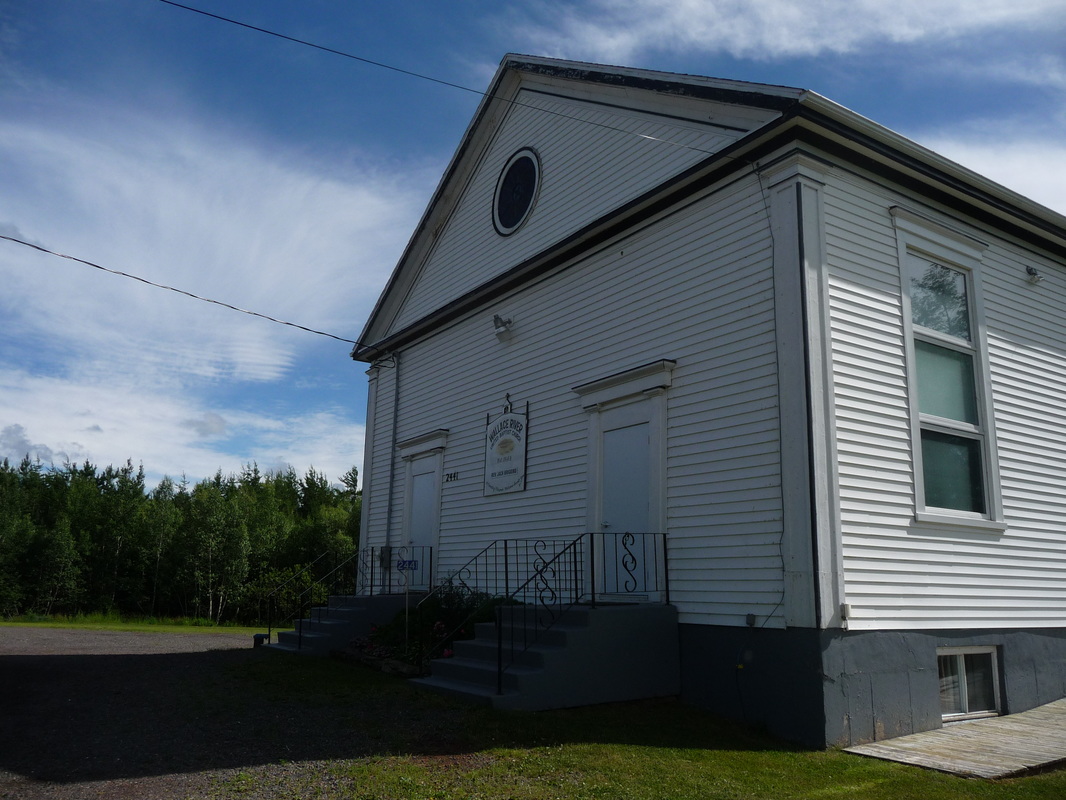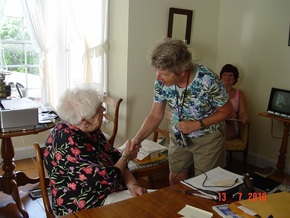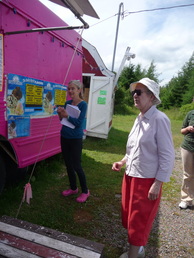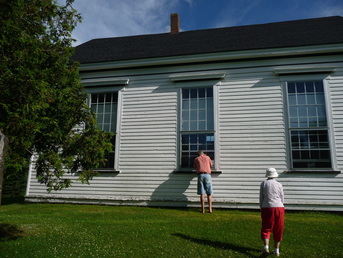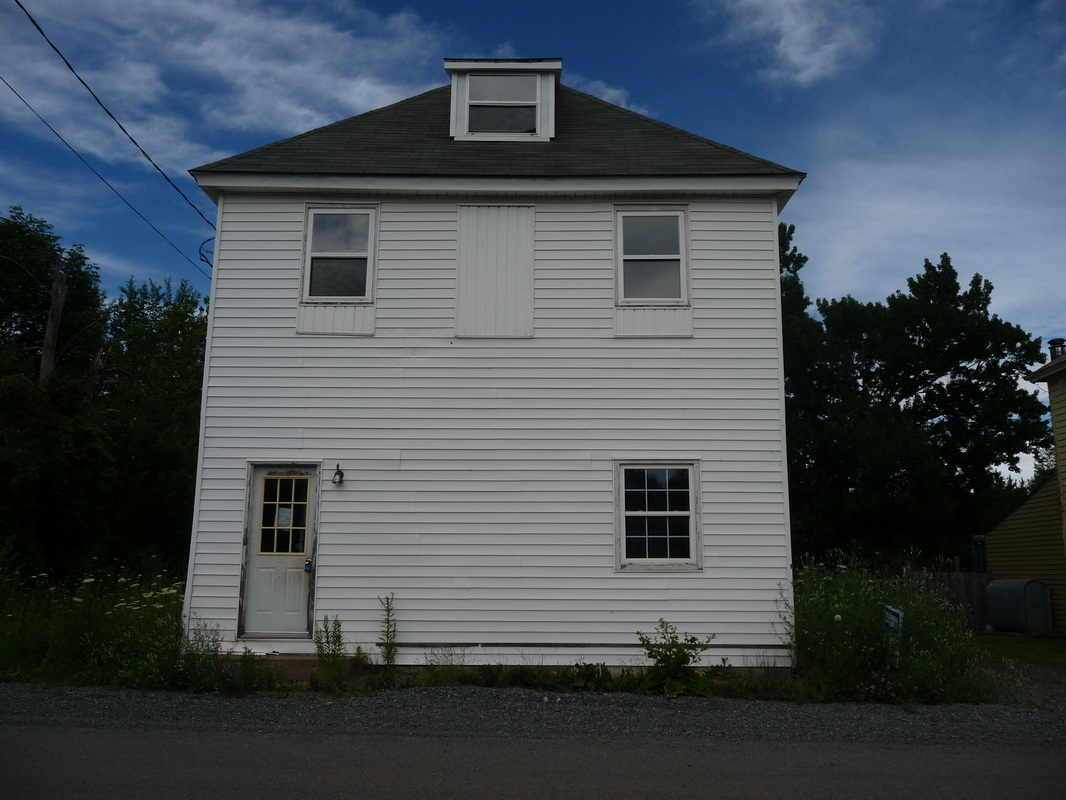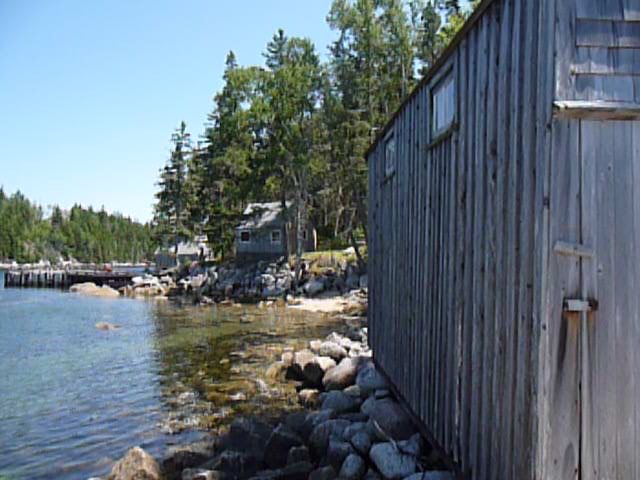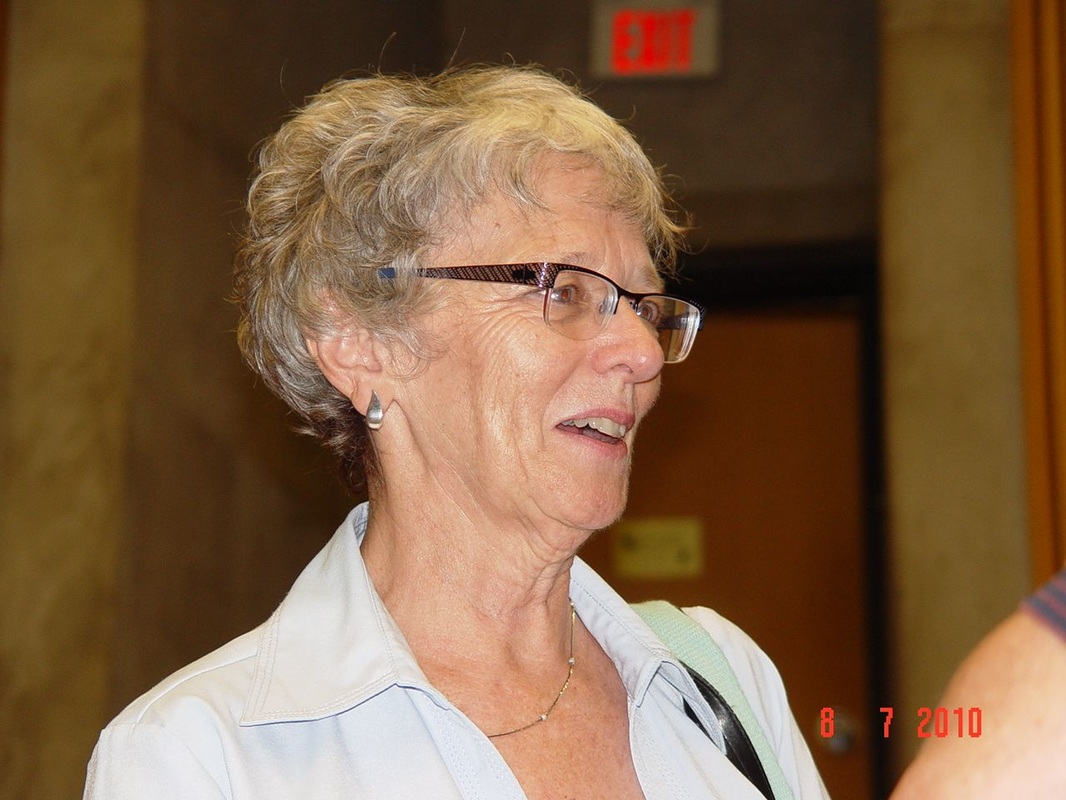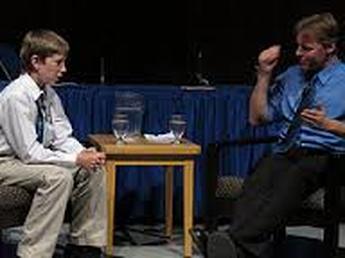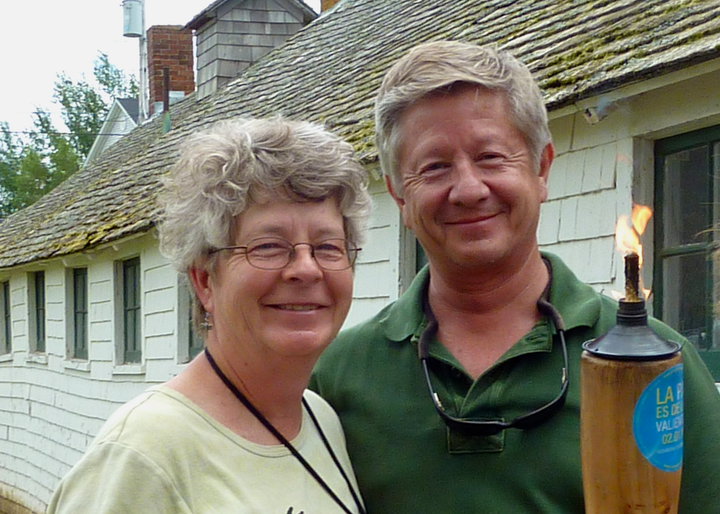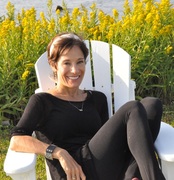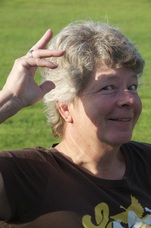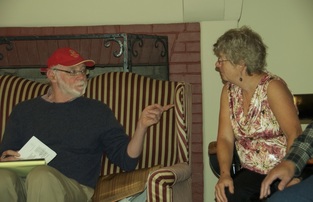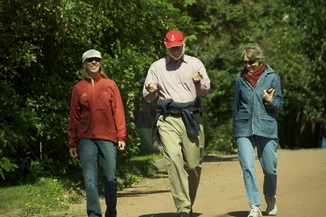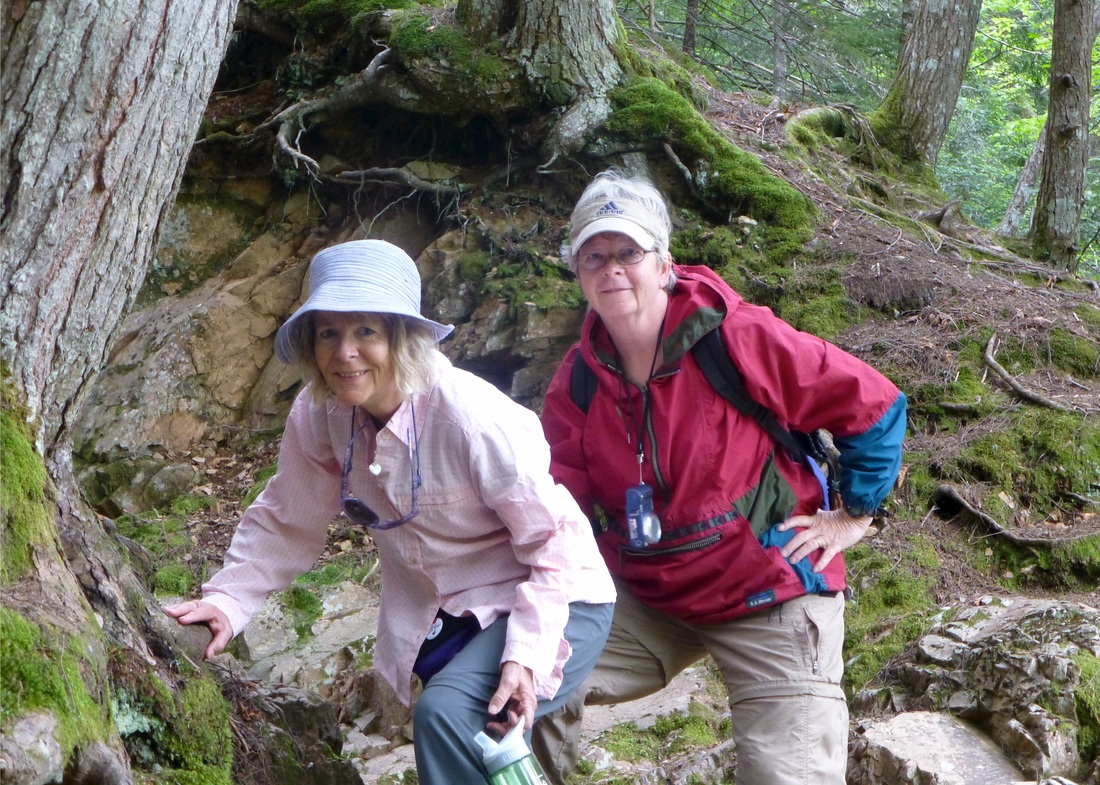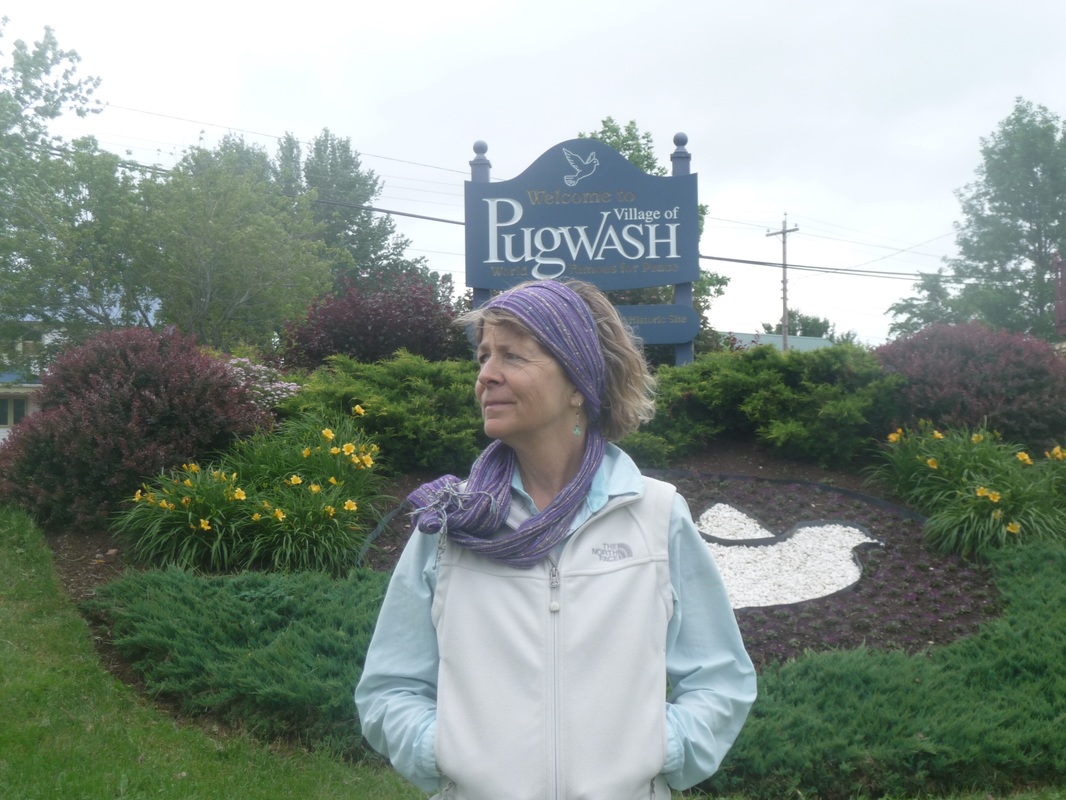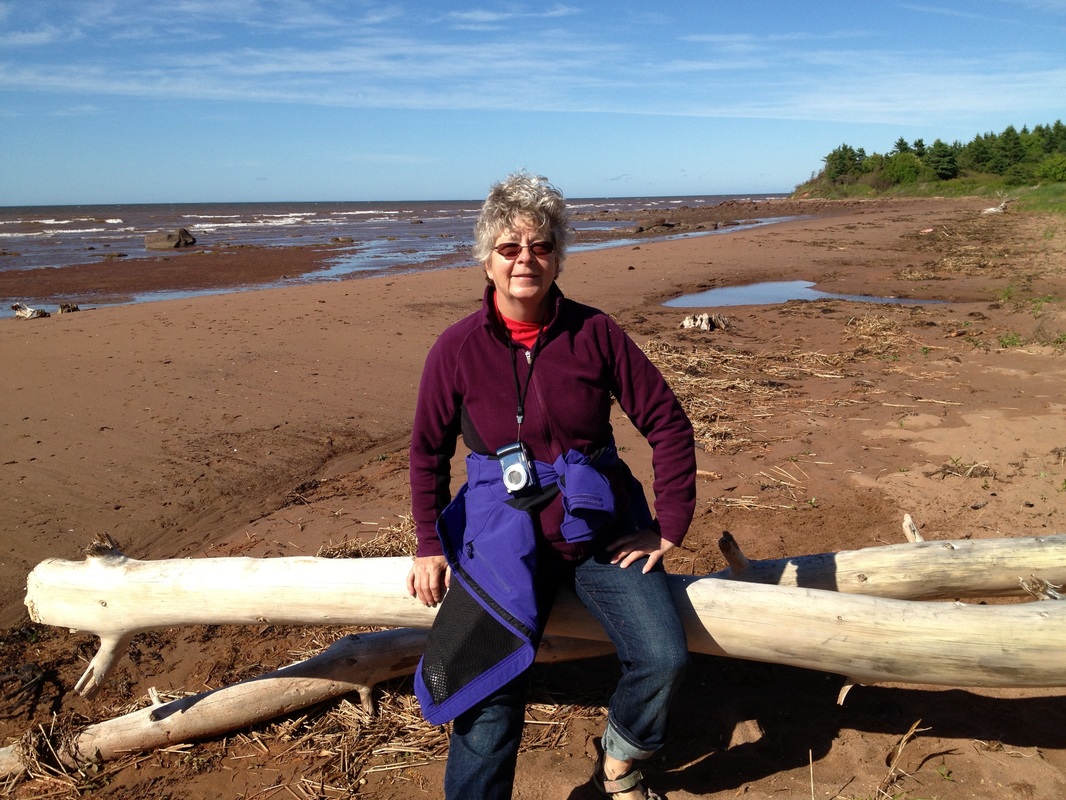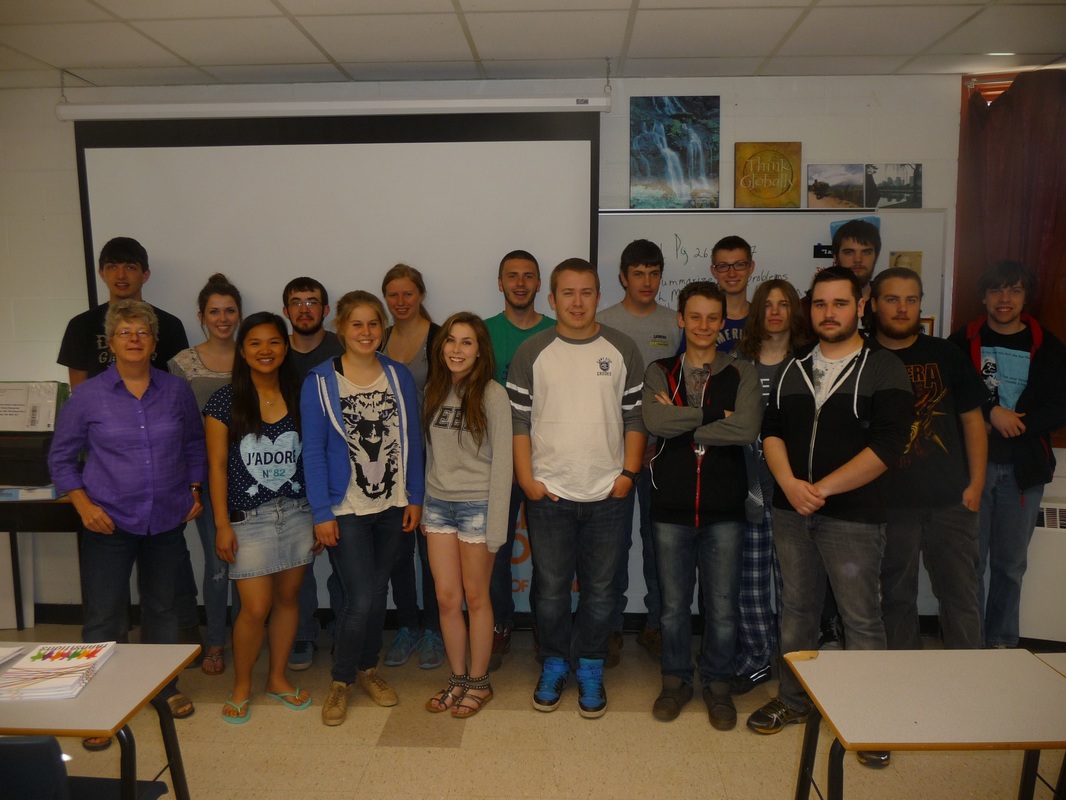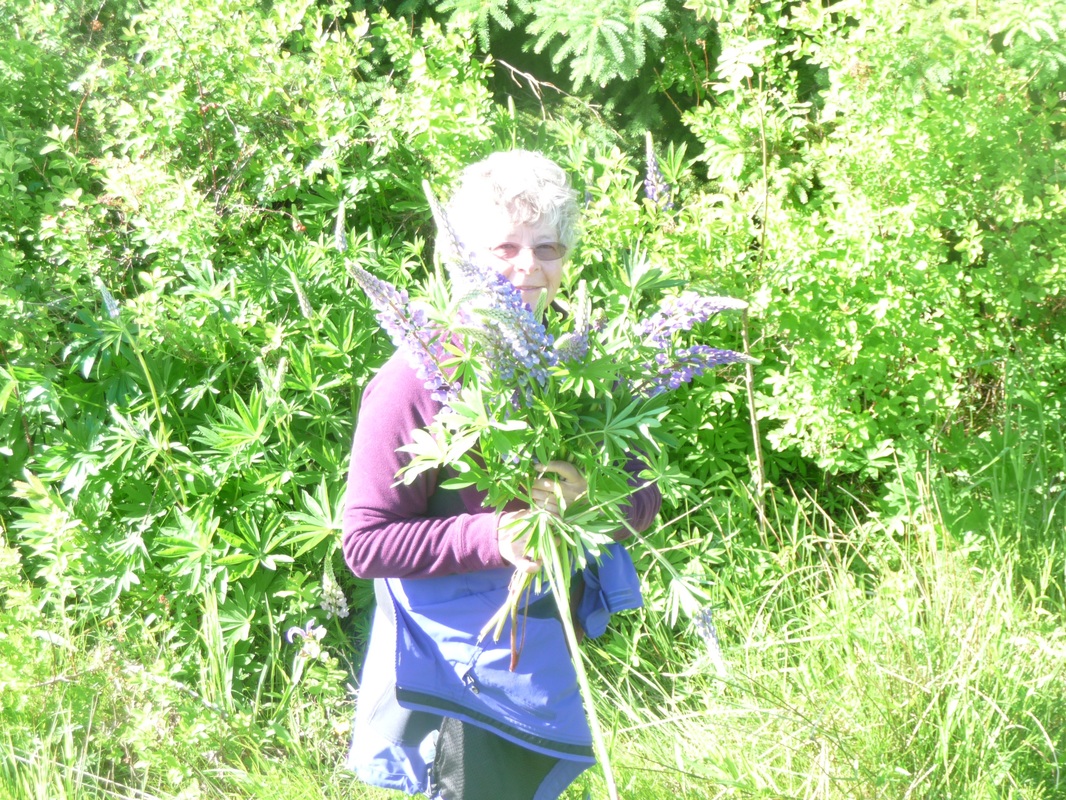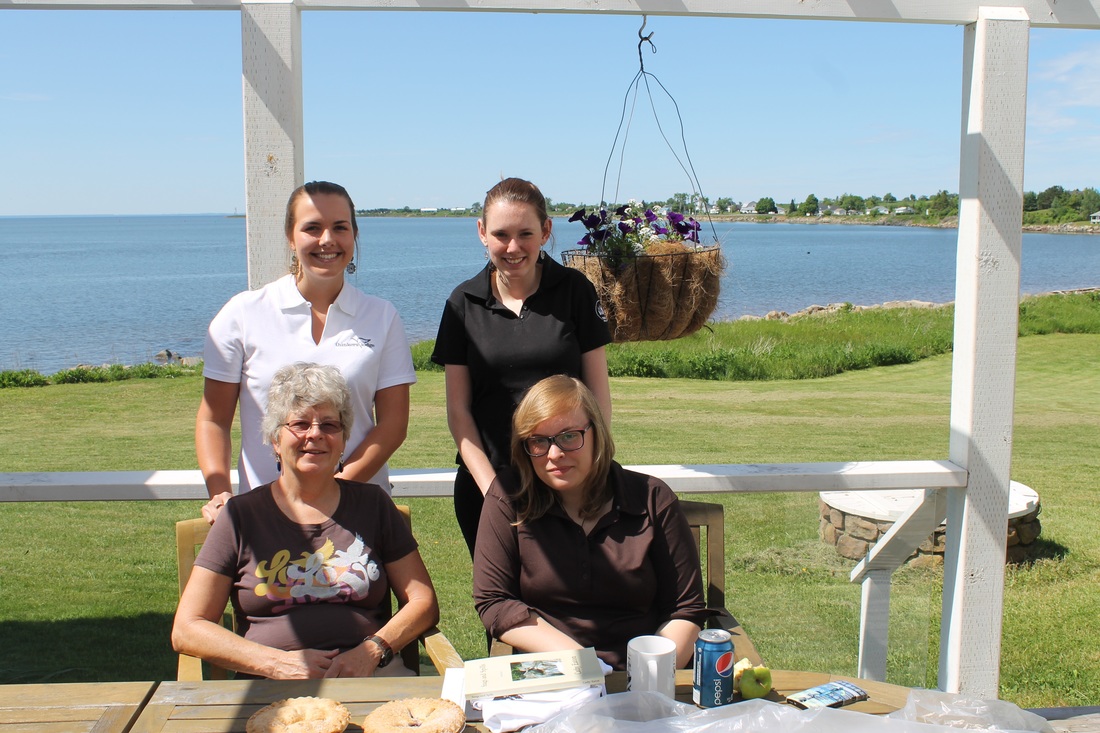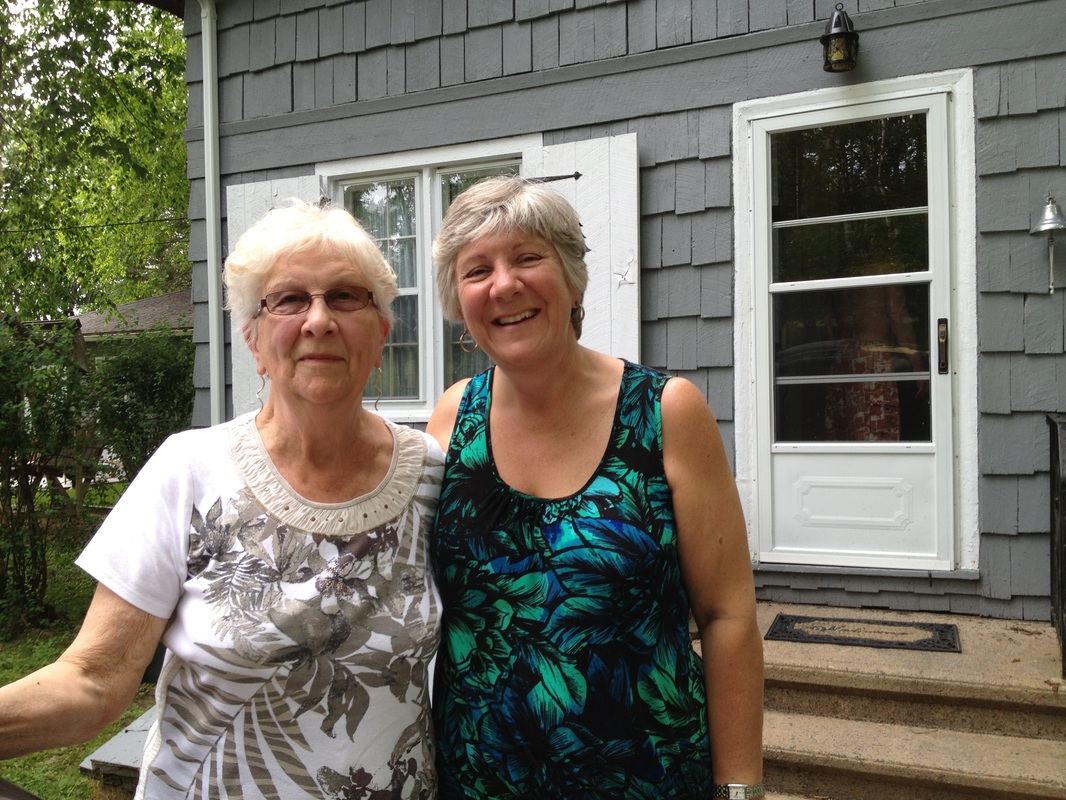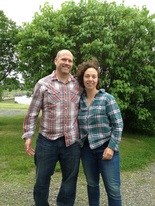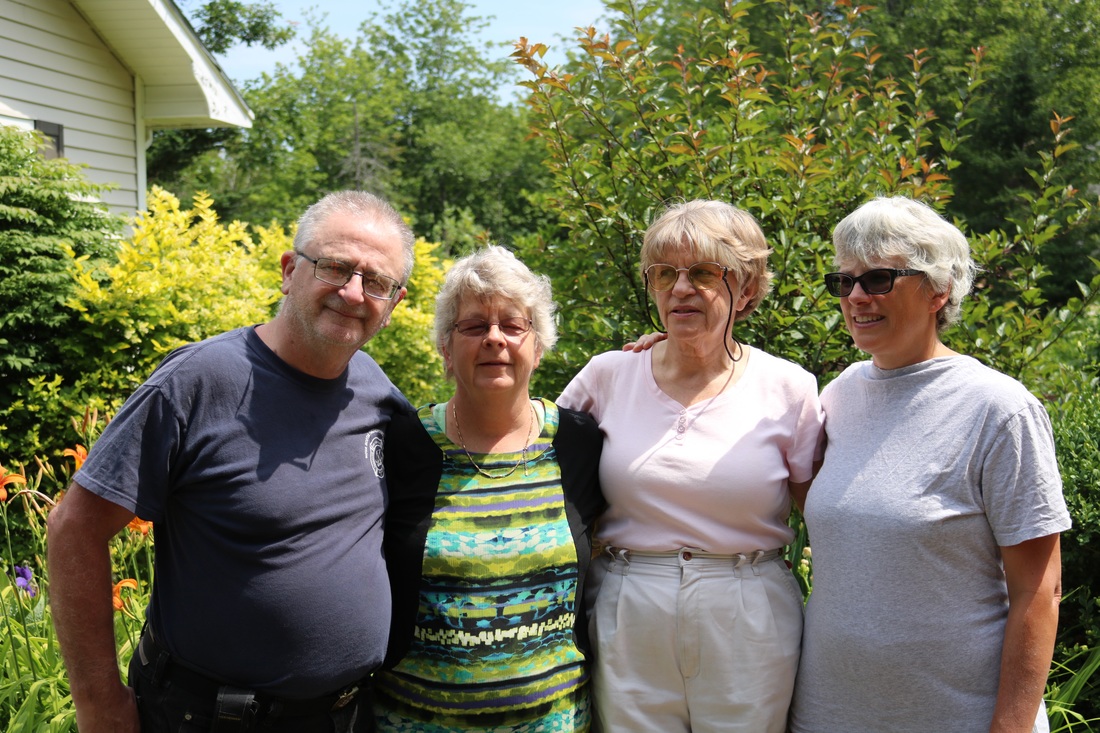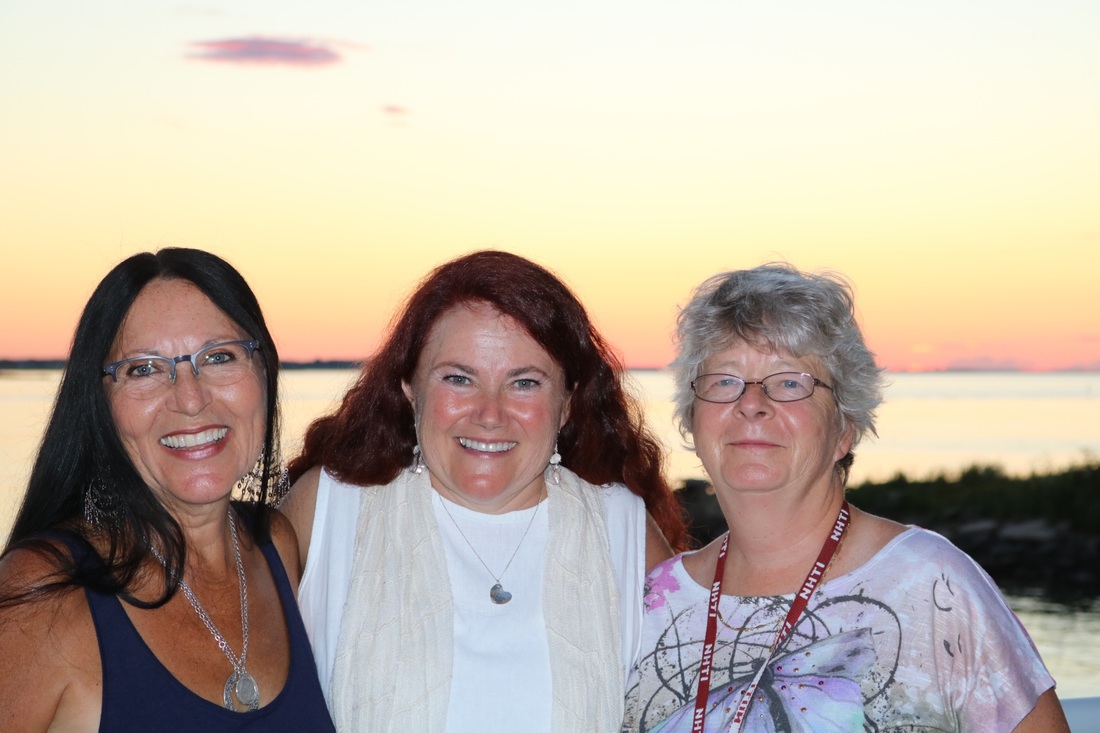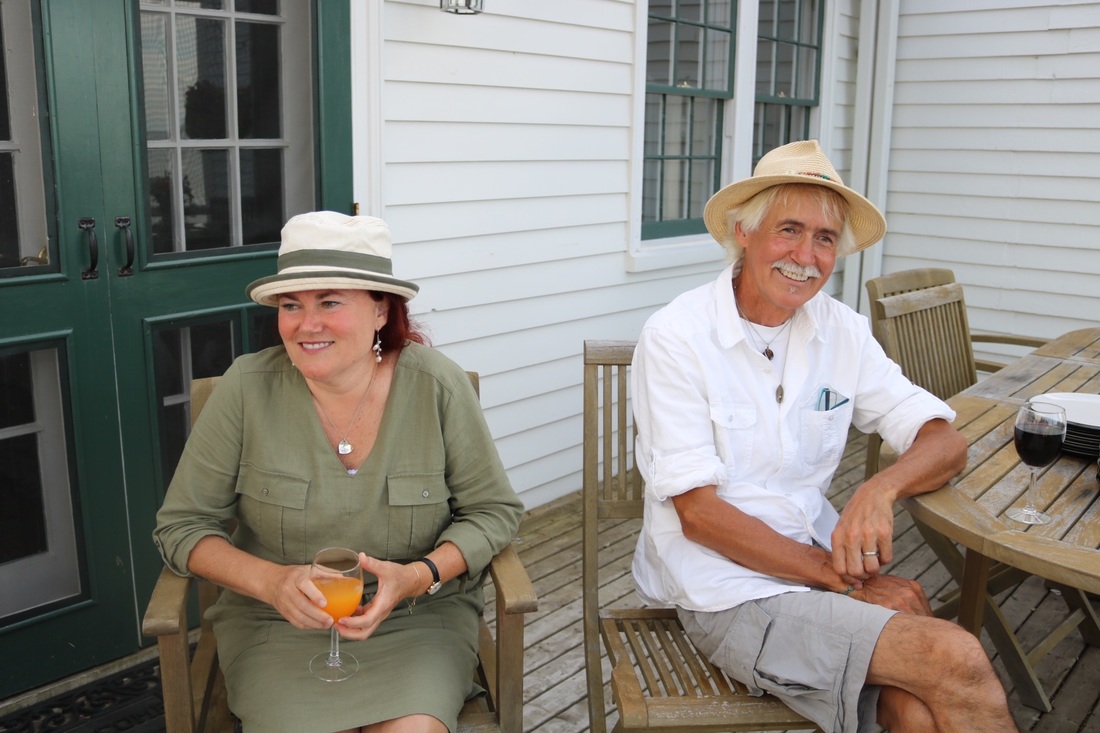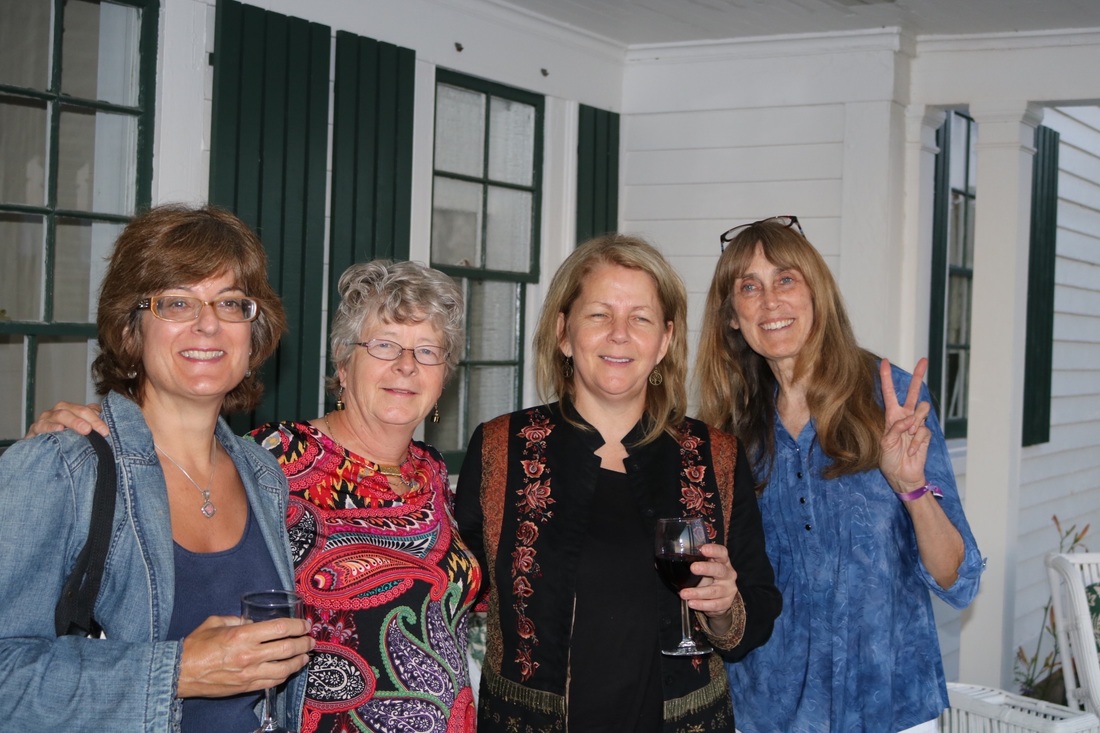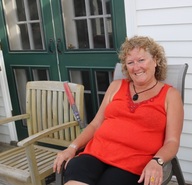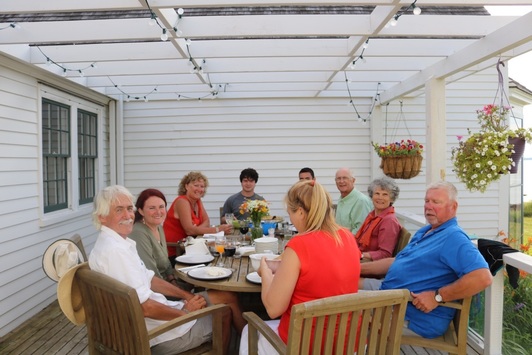Cathy Eaton interviews Cathy Eaton
Deep Cove, Nova Scotia is the place of my heart, the sanctuary and playground where I spent summers visiting my grandfather and where I canoed, fished, swam, hiked, built bonfires, gathered blueberries, feasted on fish freshly caught, picnicked, jumped off the dock, swam across the cove, played croquet, and slept in a dorm room on the third floor of a ‘cottage.” I began traveling to Deep Cove when I was two with my brothers Cy and John and where we joined older cousins. We were all supervised by athletic, energetic young caregivers. One of them Eleanor Duckworth went on to be Piaget’s assistant and a Harvard professor. Years later I learned that her mother, Muriel Duckworth, was a renown peace activist and leader of the women’s movement in Nova Scotia.
|
|
|
Grampa was central to Deep Cove. The grandchildren ate three meals a day with him, motored on the Margy, a pudgy motor boat, to numerous islands around Mahone Bay where we gathered drift wood to build large bonfires and feasted on meat pie, hot chocolate, home-made donuts and pie. Often we jumped off the boat and swam to shore. Other times, we piled in a bulky dory rowed by Bruce Schnare or Cecil Gates or Tom Zinc. We threw bread to the seagulls while Grampa rowed the long boat.
The cabin was a three-story structure designed by the well-known Halifax architect, Andrew Cobb. Grampa’s brother, Joe Eaton, was charged to find five pieces of land to show Grampa as possible sites for a summer home. My grandfather, Cyrus S. Eaton, chose magnificent vast acres off Mahone Bay. Grampa commissioned Andrew Cobb to design a house that could house several couples comfortably or twenty or more family members easily. Thus, the first floor contained a large kitchen with a coal stove and two pantries, a dining room with tables that could be combined together, a comfortable living room, and a verandah that faced the bay. The second floor had four bedrooms each equipped with a fireplace and bathroom for guests. At the far end were several more bedrooms where the chef (Jack from the railway) and the butler (Raymond Bourque) had privacy. The third floor was the domain of the grandchildren. On each side of the hallway next to a cedar closet were two large dorm rooms equipped with five or six beds – one side for the grandsons and one side for the granddaughters. When Grampa remarried Anne Eaton (Grananne), a wing with sitting room and bedroom and patio and office was added to the first floor. Ray Szabo was Grampa’s assistant from 1957 to Grampa’s death in 1979. He and his family stayed across from Houlihand Lake during the summer. (
Grampa was also our neighbor in Northfield, Ohio, where we had adjoining shorthorn cattle farms on hundreds of acres.
So, the Grampa I knew and loved, was not the extraordinarily successful steel/coal/railroad tycoon who amassed millions. He was the not the world traveler who opened dialogues with educators, scientists, communists, astronomers, cosmonauts, philosophers. He was not the peace activist, who provided Thinkers Lodge as a haven and think tank for nuclear physicists to gather and build platforms to lead the world toward nuclear disarmament. He was not the ruthless businessman who took down his opponents/enemies.
Of course, he was all those things.
But to me he was my grandfather who asked thoughtful questions and then listened attentively to the answers. He was the man I hiked with after dinner hoping to be able to keep up with his quick pace. He was the white haired imp who pointed out a humming bird outside the dining room and stole my blueberry muffin. He was the man who bet me I wouldn’t sleep outside all night without a sleeping bag beneath the sky and exposed to merciless mosquitoes. His strong arms paddled the wooden green and red canoes. He knew every tree that had been planted on the property and where it had come from. He knew all the cattle in the herd by name and by breeding. In the evening after our walk to Ben’s place, he sat in the corner chair and read while he munched on crackers. His breakfast was beyond hearty (orange juice, prunes, grapefruit, porridge, soft boiled eggs, bacon, toast, and cups and cups of hot Poland water.) He wore a canvas hat, dressed in elegant suits or cabled sweaters and khaki pants, or white shorts and a golf shirt. He walked with a cane that enabled him to move cattle and even grandchildren along. He was remarkably fit: playing tennis, riding horses, cross country skiing, swimming, canoeing, and walking miles daily. His loud sneeze always made me jump. He loved to tell the story about him and my dad as a six-year-old going canoeing with guides in Nova Scotia and dad disappearing. He had given young Cy a pocketknife and urged caution. When he found Cy lying by a stream with his hand trailing in the water, he saw a huge gash in the boy’s thumb. How Grampa roared with laughter when he recounted how his son said, “A frog bit me.”
So, the Grampa I knew and loved, was not the extraordinarily successful steel/coal/railroad tycoon who amassed millions. He was the not the world traveler who opened dialogues with educators, scientists, communists, astronomers, cosmonauts, philosophers. He was not the peace activist, who provided Thinkers Lodge as a haven and think tank for nuclear physicists to gather and build platforms to lead the world toward nuclear disarmament. He was not the ruthless businessman who took down his opponents/enemies.
Of course, he was all those things.
But to me he was my grandfather who asked thoughtful questions and then listened attentively to the answers. He was the man I hiked with after dinner hoping to be able to keep up with his quick pace. He was the white haired imp who pointed out a humming bird outside the dining room and stole my blueberry muffin. He was the man who bet me I wouldn’t sleep outside all night without a sleeping bag beneath the sky and exposed to merciless mosquitoes. His strong arms paddled the wooden green and red canoes. He knew every tree that had been planted on the property and where it had come from. He knew all the cattle in the herd by name and by breeding. In the evening after our walk to Ben’s place, he sat in the corner chair and read while he munched on crackers. His breakfast was beyond hearty (orange juice, prunes, grapefruit, porridge, soft boiled eggs, bacon, toast, and cups and cups of hot Poland water.) He wore a canvas hat, dressed in elegant suits or cabled sweaters and khaki pants, or white shorts and a golf shirt. He walked with a cane that enabled him to move cattle and even grandchildren along. He was remarkably fit: playing tennis, riding horses, cross country skiing, swimming, canoeing, and walking miles daily. His loud sneeze always made me jump. He loved to tell the story about him and my dad as a six-year-old going canoeing with guides in Nova Scotia and dad disappearing. He had given young Cy a pocketknife and urged caution. When he found Cy lying by a stream with his hand trailing in the water, he saw a huge gash in the boy’s thumb. How Grampa roared with laughter when he recounted how his son said, “A frog bit me.”
I did travel to Thinkers Lodge around 1960 for a family reunion and for Canada Day. I remember or have seen photographs of young lassies doing Scottish dancing on the stage in Eaton park. I remember my handsome second cousin, Paolo Brenciaglia, flirting with the girls. I remember being there with cousins, Mary Eaton, Farley Tobin, and Kathy Von Lewinsky. I also remember stopping on that sojourn at a nature preserve where I saw my first moose.
I didn’t return to Pugwash til 1972 when my boyfriend, Rick Greenberg, and my sister, Elizabeth, and I drove from Camden, Maine where I was a camp counselor. We visited a daughter of Aunt Eva (Grampa’s sister), then headed around Cape Breton where we camped in a wind tunnel, and then visited Grampa at Deep Cove. The next time I returned to Pugwash and stayed at Thinkers Lodge was in 2005.
I didn’t return to Pugwash til 1972 when my boyfriend, Rick Greenberg, and my sister, Elizabeth, and I drove from Camden, Maine where I was a camp counselor. We visited a daughter of Aunt Eva (Grampa’s sister), then headed around Cape Breton where we camped in a wind tunnel, and then visited Grampa at Deep Cove. The next time I returned to Pugwash and stayed at Thinkers Lodge was in 2005.
September 2005
I flew to Halifax and drove to Pugwash where I met my brother, John, and Ray Szabo, the current president of Cyrus Eaton Foundation and the head of Pugwash Park Commission. The purpose was to make the transition from Ray to John as Pugwash Park Commissioner. I began to learn about Grampa’s roots in Pugwash and the 1957 Pugwash Conference. The beginning of a Journey!
I flew to Halifax and drove to Pugwash where I met my brother, John, and Ray Szabo, the current president of Cyrus Eaton Foundation and the head of Pugwash Park Commission. The purpose was to make the transition from Ray to John as Pugwash Park Commissioner. I began to learn about Grampa’s roots in Pugwash and the 1957 Pugwash Conference. The beginning of a Journey!
On July 7, 2007, Dr. Tadatoshi Akiba, Mayor of Hiroshima, came to Pugwash, Nova Scotia on the 50th anniversary of the 1957 Pugwash Conference on Nuclear Disarmament. Eloquently and forcefully, he argued that it is the responsibility of every person, every city, every government, and every country to demand that nuclear weapons never ever be used again and that all nuclear weapons should be eliminated. I walked with Dr. Akiba from Thinkers Lodge to the high school where he urged his audience to fight against the use of nuclear weapons and where he recounted the many steps that have been taken.
On that day, Sandy Butcher, presented Joseph Rotblat’s Nobel Peace Prize to Thinkers Lodge on the west verandah.
Anne Eaton's daughter, Lissy Gulick, sang a song composed for the occasion.
Eaton family members gathered for a mini reunion. They included Cyrus Eaton’s youngest child Mac Eaton, his wife, Cynthia, his daughter, Mary and grandson Josh. Eva Webb (Cyrus’s sister) was represented by her grandsons Giovanni Brencialia and his wife Susan, their daughter, and granddaughters. Also Paolo Brencialia and his wife Sandy, residents of Pugwash, attended as did the Feathermens and Cathy and John Eaton.
On that day, Sandy Butcher, presented Joseph Rotblat’s Nobel Peace Prize to Thinkers Lodge on the west verandah.
Anne Eaton's daughter, Lissy Gulick, sang a song composed for the occasion.
Eaton family members gathered for a mini reunion. They included Cyrus Eaton’s youngest child Mac Eaton, his wife, Cynthia, his daughter, Mary and grandson Josh. Eva Webb (Cyrus’s sister) was represented by her grandsons Giovanni Brencialia and his wife Susan, their daughter, and granddaughters. Also Paolo Brencialia and his wife Sandy, residents of Pugwash, attended as did the Feathermens and Cathy and John Eaton.

On July 6 and 7, 2007, the Nobel Prize–winning Pugwash Conferences on Science and World Affairs and the Middle Powers Initiative brought together 25 scientists, diplomats and former military officers from 15 countries for a “Revitalizing Nuclear Disarmament” strategy workshop. The meeting was held near the Thinkers’ Lodge, the site of the first meeting in 1957.
Dr. Akiba, Mayor of Hiroshima spoke at the Pugwash District High School on our obligation to eliminate all nuclear weapons
Dr. Akiba, Mayor of Hiroshima spoke at the Pugwash District High School on our obligation to eliminate all nuclear weapons
In 2009 and 2010, I began collecting historical documents, letters, and photographs from the Cyrus Eaton Collection at Western Reserve Historical Society in Cleveland, Ohio. I was able to locate the Lenin Peace and photographs and documents related to 1957 Pugwash Conference on Science and World Affairs at Thinkers Lodge, photographs of Eaton family, information about the Troyka, Yuri Gargarin, participants at the conferences, Bertrand Russell, Albert Einstein, and Joseph Rotblat. Many of the documents and photographs were scanned and utilized by CREDA as they revitalized Thinkers Lodge and began its journey to becoming a national historic site. Each year I continue to locate additional material at the historical site with the gracious help of Ann Sindelar, Vicki Catozza, and Tim Beatty. In 2016 Shelley Rose from Cleveland State Universityand new member of Cyrus Eaton foundation began to help.
Lissy Gulick found a marvelous tape of her mother (Anne Eaton) reading a letter written to her father, Judge Kinder , on the 30th reunion of the 1957 conference. In the letter written originally immediately after 1957 conference, Anne Eaton describes the participates and the ice thawing between the people from so many nations. We were able to put recording and its transcript on website along with photographs Lissy provided of her mother.
In July of 2010, I traveled to Pugwash, Deep Cove, and Halifax with my dear friend Adele Wick. Together, we began doing what was at first an oral histories of people who worked at Thinkers Lodge and the Lobster Factory and grew to become a histsorical website with numerous interviews, historical documents, letters, speeches, magazine and newspaper articles, and photographs. Vivian Godfree set up interviews, and I made initial phone contact with each person before we left New Hampshire. In New Brunswick, Canada, Margaret Eaton advised us how to conduct interview and use open-ended questions. Mandy Jamieson, who was working at the Wallace Museum, helped us digitally record the interviews and later, she and I transcribed many of the interviews. Ru Ling Susie Chou, daughter of 1957 Chinese Nuclear physicist, took marvelous photographs of the four days as did Paolo Brenciaglia.
We interviewed staff at Thinkers Lodge and the Lobster Factory: Donnie Jamieson, Mary Jamieson, Norma Wriggly, Glenda Kent. Violet Williamson, her son William and his wife Faye told us about the farm house they had lived where Cyrus and Charles Eaton had lived at one time and where Margaret King had boarded. Ex-firefighters Lisa Betts and Robert Messanger recounted their heroic saving of Thinkers Lodge when an electrical malfunction triggered a fire. Terry Smith described his days driving delegates like Joseph Rotblat. Thelma Colburne told the fascinating saga of her grandfather who built the Empress Hotel and who pursued many careers as he and his family built local businesses.
In July of 2010, I traveled to Pugwash, Deep Cove, and Halifax with my dear friend Adele Wick. Together, we began doing what was at first an oral histories of people who worked at Thinkers Lodge and the Lobster Factory and grew to become a histsorical website with numerous interviews, historical documents, letters, speeches, magazine and newspaper articles, and photographs. Vivian Godfree set up interviews, and I made initial phone contact with each person before we left New Hampshire. In New Brunswick, Canada, Margaret Eaton advised us how to conduct interview and use open-ended questions. Mandy Jamieson, who was working at the Wallace Museum, helped us digitally record the interviews and later, she and I transcribed many of the interviews. Ru Ling Susie Chou, daughter of 1957 Chinese Nuclear physicist, took marvelous photographs of the four days as did Paolo Brenciaglia.
We interviewed staff at Thinkers Lodge and the Lobster Factory: Donnie Jamieson, Mary Jamieson, Norma Wriggly, Glenda Kent. Violet Williamson, her son William and his wife Faye told us about the farm house they had lived where Cyrus and Charles Eaton had lived at one time and where Margaret King had boarded. Ex-firefighters Lisa Betts and Robert Messanger recounted their heroic saving of Thinkers Lodge when an electrical malfunction triggered a fire. Terry Smith described his days driving delegates like Joseph Rotblat. Thelma Colburne told the fascinating saga of her grandfather who built the Empress Hotel and who pursued many careers as he and his family built local businesses.
Because Lissy Gulick shared a tape of Anne Eaton interviewing Cyrus Eaton as they drove around Pugwash about his early years, we tried to recreate the tour. Paolo Brenciglia drove, Mandy Jamieson taped parts of our adventure, Thelma Colburne identified the historical sites and what different sites had been over the years, I took pictures, and Adele Wick accompanied us.
That trip, Adele and I returned to Deep Cove where we swam across it. Hazel and Stan Havill, the long-time owners of the cabin and estate at Deep Cove graciously let us explore every nook and cranny of the house.
That summer we attended a conference at Mount St. Vincent in Halifax and Pugwash celebrating women who worked for peace. Alyn Ware and River Smith talked about building a culture of peace. Teen Logan MacGillivray shared his efforts to collect and distribute school supplies to Sierra Leone. Susan Tooke painted an image of Anne Eaton and Ruth Adams being painted by a young girl in back of Thinkers Lodge.
The international conference, "Being The Change: Building a Culture of Peace" explored peace education, women's activism, and contemporary global disarmament initiatives. Keynote speakers included Alyn Ware, and two senior Pugwash members, Sandra Butcher and Erika Simpson. There was also a visit to Pugwash. Alan Ware lead a peace march with torches from New Zealand starting at the Lobster Factory and continuing to the Peace Gardens. Alexa McDonough spoke at the Lobster Factory. Sandy Butcher spoke about Anne Eaton and Ruth Adams, the women of 1957 conference and how their lives focused on pursuit of peace. Vivian Godfree gave a history of Pugwash.
The international conference, "Being The Change: Building a Culture of Peace" explored peace education, women's activism, and contemporary global disarmament initiatives. Keynote speakers included Alyn Ware, and two senior Pugwash members, Sandra Butcher and Erika Simpson. There was also a visit to Pugwash. Alan Ware lead a peace march with torches from New Zealand starting at the Lobster Factory and continuing to the Peace Gardens. Alexa McDonough spoke at the Lobster Factory. Sandy Butcher spoke about Anne Eaton and Ruth Adams, the women of 1957 conference and how their lives focused on pursuit of peace. Vivian Godfree gave a history of Pugwash.
In September 2011, with Pam Neides, I went to three-day storytelling workshop at Thinkers Lodge with Jay O’Callahan and Mandy Kujawa. I told the story about six-year-old Cy Jr. going with Grampa on canoe trip in Nova Scotian wilderness and being bitten by a frog. Everyone experienced the magic of conversations, developing trust, and the willingness to take risks. With the help of the Northumberland Historical Society (Wayne in particular), Jay was able to find the graves of Charlie Robertson and Maggie Thomas and meet the daughter of the minister, the central characters of The Herring Shed, a tale about the workers in the herring industry during World War II, capturing the hard work, the heartache of loss, and the community resilience as all members rallied to support each other. They lived on Shore Road of the Northumberland Strait.
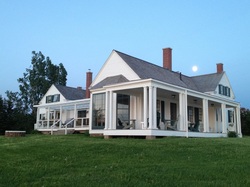 Moon rising over Thinkers Lodge
Moon rising over Thinkers Lodge
In 2013, my sister Elizabeth, my brother John, and I spent weeks of our summer at Thinkers Lodge. Elizabeth during her seven weeks supervised the interns, gave tours, organized the logistics of conferences, workshops, and weddings such as SMU Summer Peace Institue, Harbourfest, and luncheons. She added flower arrangements to brighten the Lodge.
During his three weeks, as one of the three Pugwash Park Commissioners, John continued his work raising funds to restore the Lobster Factory and continued meeting with politicians, community leaders, and bankers. He patiently dealt with complaints and forged ahead with his mission to restore Thinkers Lodge to continuing as a place for educators and scientists and others to share ideas that lead to action to better our planet and to strive for peaceful co-existence.
I continued to conduct interviews and began working on Thinkerslodgehistories.com website to share publicly all the interviews, historical documents, articles, and photographs. I also enjoyed going to yoga with Elizabeth, swimming and kayaking in Northumberland Straits, traveling to Deep Cove and reconnecting with Mabel Schnare and Connie (Gates) and Brent LeBlanc. Elizabeth and I cleaned the basement and worked on deciding what things were treasures, belonged in the Lodge or Lobster Factory, what was junk, and what should be kept.
We all pitched in to clean the lodge and prepare it for events like the Creative Nova Scotia Leadership Council where Christina Martin and Dale Murray performed. We led tours starting on the hectic and crowded Gathering of the Clans where bagpipers performed in front of the Lodge as they were judged, a glorious parade marched, youthful dancers performed Scottish dances, musicians performed on the stage, and fireworks culminated the evening. Nightly, we delighted in eating home-cooked meals on the verandahs and watching the sun set and the moon rise.
Peter Eaton was able to do screen shots of the video of the fire of the Lodge that occurred in 1996.
During his three weeks, as one of the three Pugwash Park Commissioners, John continued his work raising funds to restore the Lobster Factory and continued meeting with politicians, community leaders, and bankers. He patiently dealt with complaints and forged ahead with his mission to restore Thinkers Lodge to continuing as a place for educators and scientists and others to share ideas that lead to action to better our planet and to strive for peaceful co-existence.
I continued to conduct interviews and began working on Thinkerslodgehistories.com website to share publicly all the interviews, historical documents, articles, and photographs. I also enjoyed going to yoga with Elizabeth, swimming and kayaking in Northumberland Straits, traveling to Deep Cove and reconnecting with Mabel Schnare and Connie (Gates) and Brent LeBlanc. Elizabeth and I cleaned the basement and worked on deciding what things were treasures, belonged in the Lodge or Lobster Factory, what was junk, and what should be kept.
We all pitched in to clean the lodge and prepare it for events like the Creative Nova Scotia Leadership Council where Christina Martin and Dale Murray performed. We led tours starting on the hectic and crowded Gathering of the Clans where bagpipers performed in front of the Lodge as they were judged, a glorious parade marched, youthful dancers performed Scottish dances, musicians performed on the stage, and fireworks culminated the evening. Nightly, we delighted in eating home-cooked meals on the verandahs and watching the sun set and the moon rise.
Peter Eaton was able to do screen shots of the video of the fire of the Lodge that occurred in 1996.
In 2014, I met with Teresa Kewachuk’s World History students who had conducted interviews of John Eaton, Sandy Butcher, Vivian Godfree, Paolo Brenciaglia, Terry Smith, Teresa Kewachuk, Andrew Brown (author of biography of Joseph Rotblat), and me. The students were interviewed by French TV. Teresa Kewachuk, history teacher at Pugwash High School, began sharing her lesson plans and use of Thinkers Lodge as the students studied the cold war, the Cuban Missile crisis, and the nuclear scientists. Teresa began presenting her work at conferences. With the help of Margaret Eaton and another librarian, we sorted all the books in the basement by categories: history, philosophy, religion, physics, peace, nature, education, and travel. It is a goal of mine to have bookshelves on the second floor in the bedrooms and in the hallway to make these books accessible to visitors. I know that Grampa treasured these books and made a list of specific ones he wanted in the Lodge. We learned that the central room was turned into a library and secretary's office around 1957. I would like to find out when those two rooms were merged into one larger room.
I met Frank Allan’s daughters (Hester Allan, Beryl Arab, Sheryl Williams), son Jack, and granddaughter Margaret Allan, who gave me more details about his life on Northumberland Strait shore as well as some photographs. By marvelous coincidence we first met on July 1st at the Lobster Factory which Frank Allan had built and used as a canning factory.
Louise Cloutier, the art teacher, and members of Community in Bloom, guided the Grade 10 Visual Arts Students and the the Grade 8 Students to create benches and a garden to commemorate the original 22 scientists of the 1957 conference, Joseph Rotblat, Cyrus Eaton, and Bertrand Russell. The students in the Production Technology Class built and donated four cedar benches for the Lobster Factory. 9th grade students scraped and painted the Gate House. The students attending the prom had photographs taken outside Thinkers Lodge.
John and I met with Susan Tooke and her husband Richard Rudnicki. Richard was working on children’s book on Grampa (Cyrus Eaton). I shared many photographs and documents with him When I read part of his draft, I suggested edits and corrections, particularly suggesting that the children play crocket and not baseball. His book was published in 2016.
I visited Deep Cove, ate dinner with Hazel Havill, her daughter Sharon and son—in-law Stephen and grandson, Evan Densmore. Sharon took me on a golf cart to visit Grampa’s grave. Stephen and Evan, after launching the boat launch, took me on a marvelous boat ride to all the islands I picnicked on as a child. I was greatly honored to stay overnight in Grampa’s bedroom. The Havill family have loved and cherished the Deep Cove cabin and the peaceful grounds sine the 1980s. All were heart-broken when the cabin burned in the fall of 2015. Evan worked for several years constructing the Katiebelle, which he now sails. He and his crew sailed to Pugwash on Harbourfest and gave tours of their ship in 2016.
Vivian Godfree and Thelma Colburne interviewed Garth Mundle and Greta Dow who worked at Pagweak Tea Room.
In 2014, I met with Teresa Kewachuk’s World History students who had conducted interviews of John Eaton, Sandy Butcher, Vivian Godfree, Paolo Brenciaglia, Terry Smith, Teresa Kewachuk, Andrew Brown (author of biography of Joseph Rotblat), and me. The students were interviewed by French TV. Teresa Kewachuk, history teacher at Pugwash High School, began sharing her lesson plans and use of Thinkers Lodge as the students studied the cold war, the Cuban Missile crisis, and the nuclear scientists. Teresa began presenting her work at conferences. With the help of Margaret Eaton and another librarian, we sorted all the books in the basement by categories: history, philosophy, religion, physics, peace, nature, education, and travel. It is a goal of mine to have bookshelves on the second floor in the bedrooms and in the hallway to make these books accessible to visitors. I know that Grampa treasured these books and made a list of specific ones he wanted in the Lodge. We learned that the central room was turned into a library and secretary's office around 1957. I would like to find out when those two rooms were merged into one larger room.
I met Frank Allan’s daughters (Hester Allan, Beryl Arab, Sheryl Williams), son Jack, and granddaughter Margaret Allan, who gave me more details about his life on Northumberland Strait shore as well as some photographs. By marvelous coincidence we first met on July 1st at the Lobster Factory which Frank Allan had built and used as a canning factory.
Louise Cloutier, the art teacher, and members of Community in Bloom, guided the Grade 10 Visual Arts Students and the the Grade 8 Students to create benches and a garden to commemorate the original 22 scientists of the 1957 conference, Joseph Rotblat, Cyrus Eaton, and Bertrand Russell. The students in the Production Technology Class built and donated four cedar benches for the Lobster Factory. 9th grade students scraped and painted the Gate House. The students attending the prom had photographs taken outside Thinkers Lodge.
John and I met with Susan Tooke and her husband Richard Rudnicki. Richard was working on children’s book on Grampa (Cyrus Eaton). I shared many photographs and documents with him When I read part of his draft, I suggested edits and corrections, particularly suggesting that the children play crocket and not baseball. His book was published in 2016.
I visited Deep Cove, ate dinner with Hazel Havill, her daughter Sharon and son—in-law Stephen and grandson, Evan Densmore. Sharon took me on a golf cart to visit Grampa’s grave. Stephen and Evan, after launching the boat launch, took me on a marvelous boat ride to all the islands I picnicked on as a child. I was greatly honored to stay overnight in Grampa’s bedroom. The Havill family have loved and cherished the Deep Cove cabin and the peaceful grounds sine the 1980s. All were heart-broken when the cabin burned in the fall of 2015. Evan worked for several years constructing the Katiebelle, which he now sails. He and his crew sailed to Pugwash on Harbourfest and gave tours of their ship in 2016.
Vivian Godfree and Thelma Colburne interviewed Garth Mundle and Greta Dow who worked at Pagweak Tea Room.
In 2015, I spoke at the prom , which was held at the Lobster Factory. I worked with Jenna to plant hanging flower plants and flowers on the grounds. The students built a handicap ramp to the Lobster Factory. Teresa Kewachuk began organizing fund raisers and coffee hours to invite the community to enjoy music and dances and talks at the Lobster Factory. The first annual Country Dance was held. I worked on creating notebook that gave brief biographies and photos of the signers of the Russell-Einstein Manifestor and the 22 scientists who attended the 1957 conference. I need to revise them and cite all the sources and have links to website to find more information.
In September, Voice of Women PeacekeepHer Camp was held at Thinkers lodge and Lobster Factory as was converswations for a Compelling Future.The Sundrise Film Festival was held at the Lobster Factory in October. The first annual Thanksgiving at Thinkers Lodge Lottery was held. Writing on Fire – a Youth Writing Retreat was held at Thinkers Lodge. Read, Write, Reflect: Finding the Memori You were Meant to Write with Margarie Simmons was held at Thinkers Lodge which also hosted several weddings.
In September, Voice of Women PeacekeepHer Camp was held at Thinkers lodge and Lobster Factory as was converswations for a Compelling Future.The Sundrise Film Festival was held at the Lobster Factory in October. The first annual Thanksgiving at Thinkers Lodge Lottery was held. Writing on Fire – a Youth Writing Retreat was held at Thinkers Lodge. Read, Write, Reflect: Finding the Memori You were Meant to Write with Margarie Simmons was held at Thinkers Lodge which also hosted several weddings.
In 2016, I stayed for three weeks at Thinkers Lodge. I began reorganizing the website, trying to make it user friendly and less cluttered.
In May, 2016 Read, Write, Reflect: Finding the Memoire You were Meant to Write with Marjorie Simmins and Spring Peace Institute were held at the Lodge.
Earlier in the summer, I found a 225 page unpublished biography of Grampa by Fred Knelman at the Western Reserve Historical Society. After getting permission from his widow, I scanned it and published it on the website.The handwritten notes in the margins are probably by Grampa's assistant Betty Royan and possible by himself. It was fascinating to listen to lectures on the web about Fred Knelman. I also got permission to publish Beautiful Upon the Mountains by M. Allen Gibson and his daughter. We were excited to find a letter from Albert Einstein to Grampa written in 1947.
I helped give tours. One day a polish woman and her son came in and they translated Joseph Rotblat’s PHD diploma, and Maya Fillmore made a marvelous English copy of it that mirrored the original. I interviewed Joey Gilbert who helped in the restoration of the Lodge, Robbie Chown who worked on restoration of the Lobster Factory, Ruth McGrath who worked in Pagweak Tea room, Craig Mundle who was firefighter who helped save Lodge, Gerald Sarson whose family billeted son of Harvard professor, Vivian Godfree who shared her memories of Cecil Powell and Joseph Rotblat, I did informal interview with Thelmas Colburne about her grandfather building the red brick school house. I spent three hours with Paolo Brenciaglia learning more about his roles at Thinkers Lodge and his grandmother (Eva Webb) and her children. Mary Jamieson during kayaking and swimming shared more of her memories and lent me a photograph to scan of her and Joseph Rotblat and another of the whole staff that worked at the 50th reunion of the 1957 conference.
I scanned for many, many hours until my eyes were often bleary and blurry. I added material on Joseph Rotblat and Bertrand Russell. I began adding articles written by Cyrus Eaton and about Cyrus Eaton. When I visited Peter and Sheri Eaton and Mary Eaton and Ben and Angus, Sheri gave me many photographs and materials on the Eatons from Uncle Mac.
This summer we had a dance after Harbourfest with the band. We served beer and wine. We had an open mike and band fundraiser, and many of the performers from the Chatter Box Café performed. Quintin Merlin and Caleb designed a boat from cardboard, ducttape, and paint to enter in Harbour Fest competition. Maya Fillmore decorated it. Bonnie Bond and John Caraberis hosted Wednesday nite conversations with Quita Gray of the Sugar Moon Farm, Amy Larkin, and Rehabilitating Wildlife with Helen VanDoninck.
We hung the signed photographs (to Cyrus Eaton) of the Prime Ministers of Canada. A visitor came up with idea to invite Trudeau’s son, the new prime minister, to Thinkers Lodge.
I began reading biography of Charles Eaton (Prophet in the House) published in 1967, Marcus Gleisser's revised 2005 biography of Cyrus Eaton called The World of Cyrus Eaton, Fred Knelman’s biography of Cyrus Eaton, and Andrew Brown’s biography of Joseph Rotblat. Retirements means I can expand my learning horizons about these people.
Next year is the 150th anniversary of Canada and the 70th anniversary of the 1957 Conference, so let’s find ways to get grants and have energizing conferences and workshops. Teresa is hoping Japanese peace boat will come
In May, 2016 Read, Write, Reflect: Finding the Memoire You were Meant to Write with Marjorie Simmins and Spring Peace Institute were held at the Lodge.
Earlier in the summer, I found a 225 page unpublished biography of Grampa by Fred Knelman at the Western Reserve Historical Society. After getting permission from his widow, I scanned it and published it on the website.The handwritten notes in the margins are probably by Grampa's assistant Betty Royan and possible by himself. It was fascinating to listen to lectures on the web about Fred Knelman. I also got permission to publish Beautiful Upon the Mountains by M. Allen Gibson and his daughter. We were excited to find a letter from Albert Einstein to Grampa written in 1947.
I helped give tours. One day a polish woman and her son came in and they translated Joseph Rotblat’s PHD diploma, and Maya Fillmore made a marvelous English copy of it that mirrored the original. I interviewed Joey Gilbert who helped in the restoration of the Lodge, Robbie Chown who worked on restoration of the Lobster Factory, Ruth McGrath who worked in Pagweak Tea room, Craig Mundle who was firefighter who helped save Lodge, Gerald Sarson whose family billeted son of Harvard professor, Vivian Godfree who shared her memories of Cecil Powell and Joseph Rotblat, I did informal interview with Thelmas Colburne about her grandfather building the red brick school house. I spent three hours with Paolo Brenciaglia learning more about his roles at Thinkers Lodge and his grandmother (Eva Webb) and her children. Mary Jamieson during kayaking and swimming shared more of her memories and lent me a photograph to scan of her and Joseph Rotblat and another of the whole staff that worked at the 50th reunion of the 1957 conference.
I scanned for many, many hours until my eyes were often bleary and blurry. I added material on Joseph Rotblat and Bertrand Russell. I began adding articles written by Cyrus Eaton and about Cyrus Eaton. When I visited Peter and Sheri Eaton and Mary Eaton and Ben and Angus, Sheri gave me many photographs and materials on the Eatons from Uncle Mac.
This summer we had a dance after Harbourfest with the band. We served beer and wine. We had an open mike and band fundraiser, and many of the performers from the Chatter Box Café performed. Quintin Merlin and Caleb designed a boat from cardboard, ducttape, and paint to enter in Harbour Fest competition. Maya Fillmore decorated it. Bonnie Bond and John Caraberis hosted Wednesday nite conversations with Quita Gray of the Sugar Moon Farm, Amy Larkin, and Rehabilitating Wildlife with Helen VanDoninck.
We hung the signed photographs (to Cyrus Eaton) of the Prime Ministers of Canada. A visitor came up with idea to invite Trudeau’s son, the new prime minister, to Thinkers Lodge.
I began reading biography of Charles Eaton (Prophet in the House) published in 1967, Marcus Gleisser's revised 2005 biography of Cyrus Eaton called The World of Cyrus Eaton, Fred Knelman’s biography of Cyrus Eaton, and Andrew Brown’s biography of Joseph Rotblat. Retirements means I can expand my learning horizons about these people.
Next year is the 150th anniversary of Canada and the 70th anniversary of the 1957 Conference, so let’s find ways to get grants and have energizing conferences and workshops. Teresa is hoping Japanese peace boat will come

